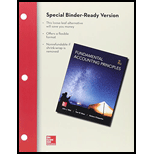
Concept explainers
Concept Introduction
Cash: It includes Cash in Hand & Deposits with Bank.
Cash Equivalents: It includes those investments which are short term investment and highly liquid i.e. maturity period is of three months or less.
Operating Activities: Operating Activities are the principal revenue generating activities of enterprise. In other words activities that are not financing and investing activities.
Sales: Sales includes the amount received from customer by selling the goods and services in the normal course of business.
Purchases: It is the amount spent for purchasing the goods meant to be resold.
Accounts Payable: The amount paid against purchase of goods and services in normal course of business. It is normally classified as Current Liabilities.
Rules for T-Shape Account: As described above, the Amount received/paid can be calculated by preparing the T-Shape Account. The Rules for preparing the T-Shape Accounts is mentioned below:
| Nature of Account | Debit Side | Credit Side |
| Asset Account | Increases | Decrease |
| Liabilities Account | Decreases | Increase |
| Revenue Account | Decreases | Increase |
| Expenses Account | Increases | Decrease |
| Capital Account | Decreases | Increase |
To Calculate:
- Cash Received from Customer
- Cash Paid for Rent
- Cash Paid for Inventory
Want to see the full answer?
Check out a sample textbook solution
Chapter 16 Solutions
Loose Leaf for Fundamentals of Accounting Principles and Connect Access Card
- Not use ai solution please and accounting questionarrow_forwardDavenport Sweets Inc. sold its chocolate division, resulting in a loss of $80,000. Assuming a tax rate of 30%, the loss on this disposal will be reported on the income statement at what amount?arrow_forwardWhat is the amount of current liabilities the firm's has?arrow_forward
- Help me this general accounting questionsarrow_forwardOn 2015/1/1, Samantha Ltd. purchased machinery for $60,000. The useful life is 8 years with a salvage value of $6,000. The company uses the double declining balance method. What is the second year's annual depreciation expense (2016/12/31)?arrow_forwardHelp me with thisarrow_forward

 AccountingAccountingISBN:9781337272094Author:WARREN, Carl S., Reeve, James M., Duchac, Jonathan E.Publisher:Cengage Learning,
AccountingAccountingISBN:9781337272094Author:WARREN, Carl S., Reeve, James M., Duchac, Jonathan E.Publisher:Cengage Learning, Accounting Information SystemsAccountingISBN:9781337619202Author:Hall, James A.Publisher:Cengage Learning,
Accounting Information SystemsAccountingISBN:9781337619202Author:Hall, James A.Publisher:Cengage Learning, Horngren's Cost Accounting: A Managerial Emphasis...AccountingISBN:9780134475585Author:Srikant M. Datar, Madhav V. RajanPublisher:PEARSON
Horngren's Cost Accounting: A Managerial Emphasis...AccountingISBN:9780134475585Author:Srikant M. Datar, Madhav V. RajanPublisher:PEARSON Intermediate AccountingAccountingISBN:9781259722660Author:J. David Spiceland, Mark W. Nelson, Wayne M ThomasPublisher:McGraw-Hill Education
Intermediate AccountingAccountingISBN:9781259722660Author:J. David Spiceland, Mark W. Nelson, Wayne M ThomasPublisher:McGraw-Hill Education Financial and Managerial AccountingAccountingISBN:9781259726705Author:John J Wild, Ken W. Shaw, Barbara Chiappetta Fundamental Accounting PrinciplesPublisher:McGraw-Hill Education
Financial and Managerial AccountingAccountingISBN:9781259726705Author:John J Wild, Ken W. Shaw, Barbara Chiappetta Fundamental Accounting PrinciplesPublisher:McGraw-Hill Education





